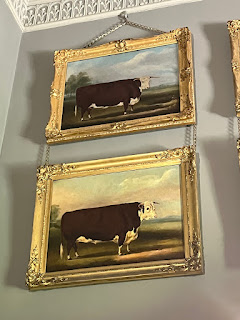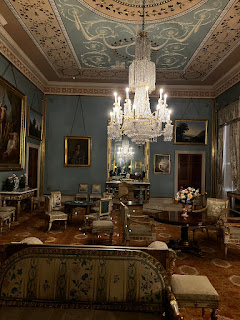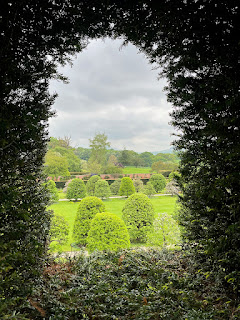The stable yard features a clever presentation regarding the life of bees and the importance of protecting them.
Saturday, May 13, 2023
Blue Skies in Shropshire!
The stable yard features a clever presentation regarding the life of bees and the importance of protecting them.
Friday, May 12, 2023
Exploring a Unique World Heritage Site in Wales
You were probably expecting to see a post on beautiful gardens with a castle, as that seems to have been the theme as of late. And, guess what? You are right!
Today's morning adventure began at Powis Castle, a bit south of where we are staying.
The castle didn't open until noon, so we took advantage of the time and perused the gardens.
The weather wasn't the best for photographs, but we couldn't control that. It certainly didn't distract from the amazing gardens at Powis.
I do wish that I could tell you more about the castle, but there were no information boards. No photos were permitted to be taken inside for some reason, so I won't be sharing any favorites here. The interior was huge, and the original building had been a Medieval fortress at one time. The one guide pointed out to me that the floor boards as well as the ornate ceilings were original from the mid 1500s. Kind of amazing, considering that they were in excellent shape.
But, as you can see, there was certainly a LOT of effort put into the design of the gardens, particularly close to the back of the house.
If you think those giant shrubs look a bit odd, then you aren't alone. These yew trees were planted in 1680 and during the first century of growth, they were pruned into a cone shape.
The desired look of shrubbery changed, and the trees were left to grow into a "natural" yew shape. After considerable time, it was decided that the shrubs should be more refined and pruned into "dome" shapes which is how they are trimmed today. It takes a crew of many gardeners three months to complete the pruning that is done yearly on these Yew trees.
What I found to be entertaining was the carefully cut out windows and walkways, as well as alcoves for sitting on a bench nestled beneath.
And I do have to admit that I never saw apple trees pruned into shapes like the ones planted here. What a clever idea!
After our disappointing inside tour, we headed to Pontcysyllite Aqueduct.
But first, we stopped at the Chapel Tea house that had been recommended to us.
It was delicious!
The Aqueduct was built by Thomas Telford from 1795 to 1805. It stands over the River Dee with the central columns at a height of 126 feet. It was made a UNESCO site in 2009, for outstanding value. The Aqueduct was designed to extend the canals that transported people and goods from one village to another. A horse would walk along the canal, pulling the boats along.
Honestly, I don't know how those horses managed to cross at that height! I must admit that I became extremely anxious on the way over, and, again, on the way back! Especially when sharing the sidewalk with other people coming the other direction.
I did manage to push aside my fears to take a couple of photographs.
Marty took the last photo. I just might be gritting my teeth!
The next village in line along this in-the-air canal is Llangollen. Don't ask me how to pronounce it as the double ll makes quite a harsh sound when spoken. The town is considered to be part of the 11 mile stretch making up the UNESCO site.
We went to park the car and realized that we needed a Pay and Display ticket to pop in our window. When we went to the machine to purchase the ticket, imagine our surprise to find the directions to be in Welsh with no English choice! Luckily, we had used a machine at the aqueduct and were able to remember the directions to complete the transaction.
Llangollen certainly had some interesting sites to discover. Right out of the parking lot was a Royal mailbox, festively decorated for the Coronation last weekend.
































































































